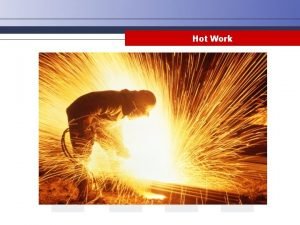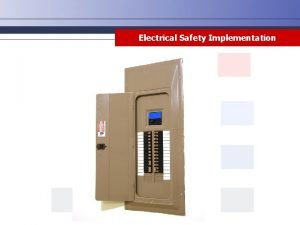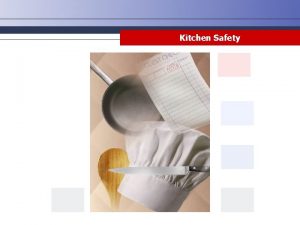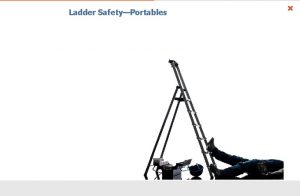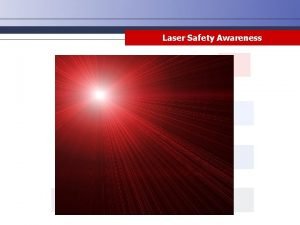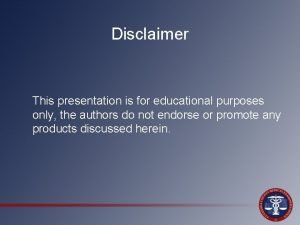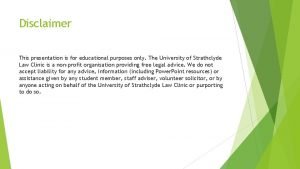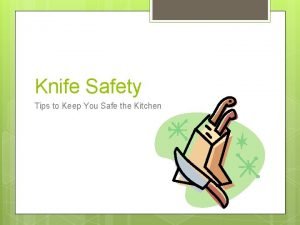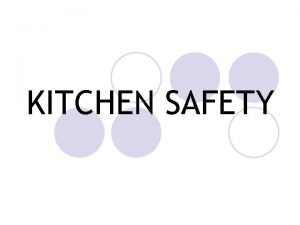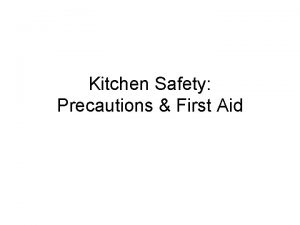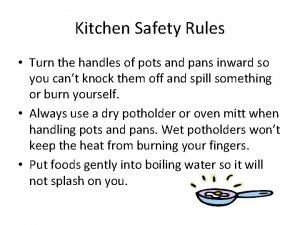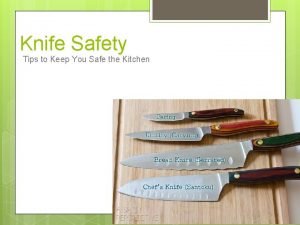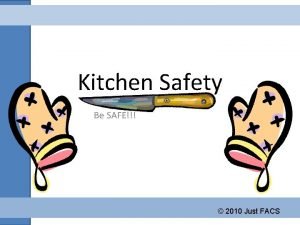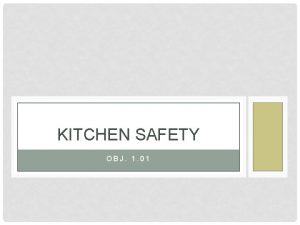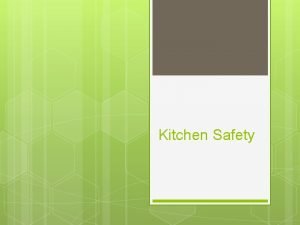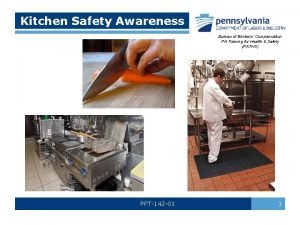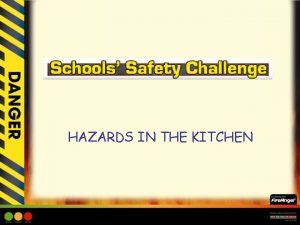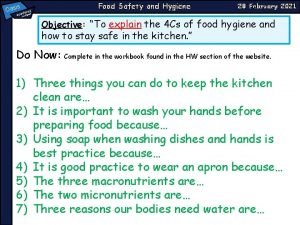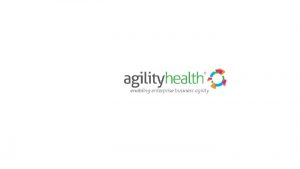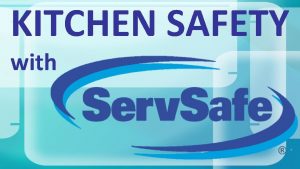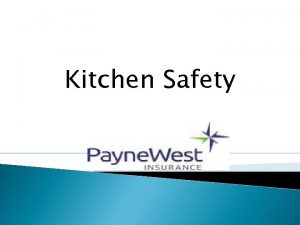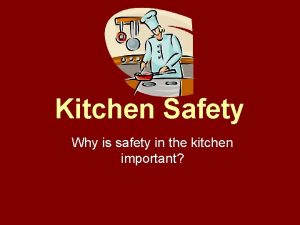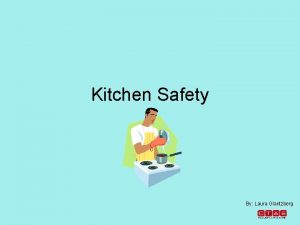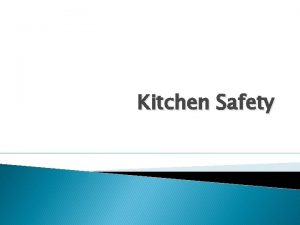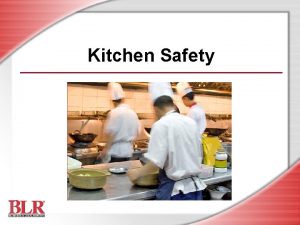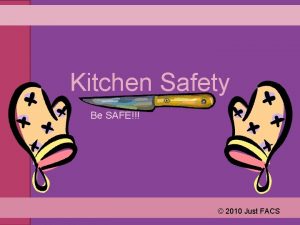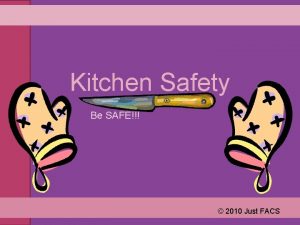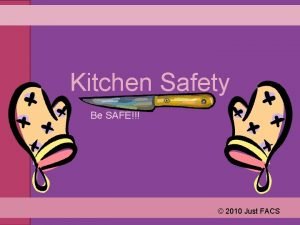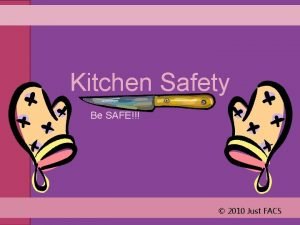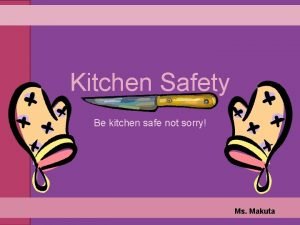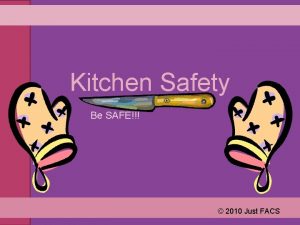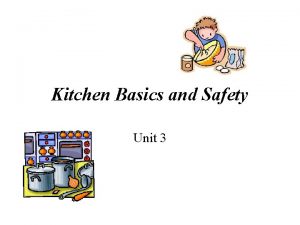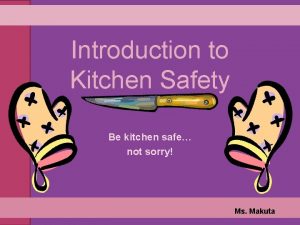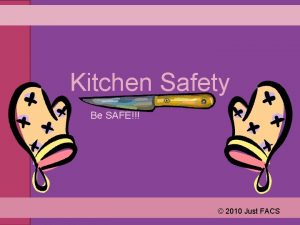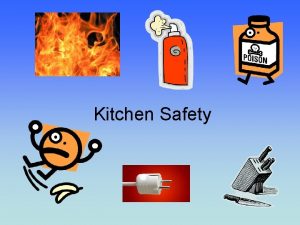Kitchen Safety Disclaimer This training material presents very




















































- Slides: 52

Kitchen Safety

Disclaimer • This training material presents very important information. • Your organization must do an evaluation of all exposures, applicable codes and regulations, and establish proper controls, training, and protective measures to effectively control exposures and assure compliance. • This program is neither a determination that the conditions and practices of your organization are safe nor a warranty that reliance upon this program will prevent accidents and losses or satisfy local, state or federal regulations. • All procedures and training, whether required by law or not, should be implemented and reviewed by safety and risk management professionals, and legal counsel to ensure that all local, state and federal requirements are satisfied.

Course Outline – Kitchen Safety 1. Why Take Kitchen Safety Training? 2. Operating Machinery Safely 3. Machine Guarding 4. Knife Safety 5. Ergonomic Awareness 6. Avoiding Burns 7. Fire Hazards 8. Summary

Why Take Kitchen Safety Training? Understanding the importance of kitchen safety: • High production kitchens are very busy places with many hazards. • Good kitchen management always addresses safety. • Each of the many tasks and machines in kitchens presents its own potential risk of injury. • All jobs can be performed safely if proper procedures are followed. • This training program describes the many kitchen hazards and presents methods for avoiding injuries.

Operating Machinery Safely Pre-operation responsibilities: • Before using any machine be certain that you know how to operate it safely. • Receive and follow specific training for each machine you operate. • Always ask for help if you are not sure how to do a certain task. • Required personal protective equipment must be established through a Hazard Assessment performed to identify hazards and needed controls (including Personal Protective Equipment) for each task. • Employees must properly and consistently wear all required Personal Protective Equipment (PPE) required for the job.

Operating Machinery Safely Pre-operation responsibilities (continued): • Follow manufacturer instructions for machine use and cleaning. • Be sure that all required machine guarding is in place and functioning properly. • Do not wear loose clothing or jewelry that could become caught in moving parts. This man’s apron got caught in the machine and pulled him into harms way.

Operating Machinery Safely Mincers, choppers, dicers, slicers: • Machines with cutting blades require extreme attention to hand safety. • Always use push sticks or tamps to feed or remove food from these types of machines. • Never use your hands to feed small pieces of food into slicers. • Blades must be sharp. Dull blades can increase the amount of force required to cut, increasing risk of sudden contact with blades.

Operating Machinery Safely Mincers, choppers, dicers, slicers (continued): • Utilize all required machine guarding to prevent accidental access to the cutting blades. Never bypass safety guards! • Never open a machine or put your hands into a machine to stir contents or to guide food while it is operating. • Turn off and unplug the machine before disassembling, cleaning, or servicing. • Never turn a machine on until you are certain no one will be injured.

Operating Machinery Safely Food processors and mixers: • Mixers can appear harmless, but care must be taken to avoid getting yourself tangled in moving parts. • Portable, vibrating, mixing machines should be securely fastened to benches or tabletops. • Do not attempt to remove items that have fallen into the food mixture while the machine is mixing.

Operating Machinery Safely Food processors and mixers (continued): • Do not open the lids of processors to stir contents while food is processing. • Be sure the processor is off before opening the lid or adding items. • Turn off and unplug machinery before cleaning or removing a blockage. • Use all required machine guards. • Do not wear loose clothing. • Long hair must be tied back. Mixer with guarding

Operating Machinery Safely Microwave ovens: • To provide for easy lifting of hot foods, install microwave ovens at waist-level and within short reach. • Operate microwave ovens according to the manufacturer's instructions, and precheck it prior to use. • Always cover foods being cooked in microwave ovens to avoid splattering. • Use caution when opening hot, tightly covered food containers as they may be under pressure. Open them away from your face and body. A damaged microwave oven may emit non-ionizing radiation.

Operating Machinery Safely Microwave ovens (continued): • Use appropriate personal protective equipment, such as oven mitts or hot pads when removing foods from microwave ovens. • Make sure oven door seals are in good condition and free from food or grease buildup. • Do not use a microwave oven if its door is damaged or doesn't lock properly.

Operating Machinery Safely Microwave ovens (continued): • Do not put metals, foil, or whole eggs into microwave ovens. • Keep the interiors of microwave ovens very clean. • If you notice any sparking inside a microwave oven, immediately turn off the oven, unplug it, report the incident to your supervisor, and do not use the oven until the problem has been addressed. • Be advised that microwave ovens may interfere with functioning of some heart pacemakers. Posting is required in areas where they are used alerting people of this hazard. • Be aware that food cooked in a microwave oven can remain hot long after the oven turns off. Always be careful when handling hot food.

Operating Machinery Safely Steamers and pressure cookers: • Follow manufacturer instructions. Only use if trained and authorized. • Work carefully around steam and high pressure as serious burns can occur. • When a steamer is on, do not open its door. • Turn off the steam and wait a couple of minutes before releasing the pressure and opening the door. • Clear the area around the steamer before opening. • Open the steamer door while standing to the side so that the door is between you and the steamer opening.

Operating Machinery Safely Steamers and pressure cookers (continued): • Use oven mitts to remove hot trays from the steamer. • Place hot, dripping, steamer trays on a cart for transport. – If trays are carried by hand, they will drip on the floor and create a slip hazard. • If steamers are stacked, remove the tray from the top steamer first, then from the lower steamer, in order to prevent burns caused from rising steam.

Operating Machinery Safely Coffee maker safety tips: • Do not position hot coffee makers close to the edge of countertops where people passing by may come into contact with them. • Always double-check to make sure a coffee filter is in place before starting the flow of hot water. • Do not remove or handle any filter before the hot water has stopped dripping. • Never stick your fingers into the chamber of a coffee grinder to get beans to drop into the grinder. – Tapping on the outside of the container will encourage beans to drop. Unplug machine before unclogging or when working on it.

Machine Guarding Purpose of machine guarding: • Wherever the potential exists for clothing or body parts to become entangled in the moving parts of machinery, guarding is essential. • Machine safeguarding is required by law. • It isolates hazards and controls or eliminates the potential for injuries like crushed fingers or amputated hands, by preventing access to the moving parts. With proper guarding, hands cannot reach the moving parts. NEVER reach into a machine unless it is locked out!

Machine Guarding Requirements: • Be sure that proper machine guards are in place to protect the operator and all nearby workers. • Use tamps, push sticks, or other hand tools to feed food into or remove food from grinders, slicers, and choppers.

Knife Safety Safe knife-use practices: • Knives and other sharp tools require extreme care in use and storage. • All those who prepare food in busy kitchens are exposed to the potential of cuts from tools such as knives and cleavers. • All workers must follow safe knifeuse practices. • Keep knives sharpened at all times.

Knife Safety Avoiding cuts: • Using knives properly is the best way to avoid being cut. • Use the appropriate knife only for its intended cutting job. • Always cut away from your body. • Keep your fingers and thumbs out of the cutting line. • Use appropriate protective clothing, such as aprons and cut-proof gloves. Bad Position: The operator’s thumb is inside the cutting line and at risk. Also, no cut glove is being used!

Knife Safety Protective gear: • Metal and Kevlar mesh gloves protect against blade cuts. • Heavy rubber gloves protect against puncture wounds. • Do not wear gloves when working around moving machine parts where there is the potential for being pulled into the machine.

Knife Safety Handle with care: • If you drop a knife, let it fall - do not try to catch it. • Carry a knife with the cutting edge angled slightly away from your body and with the tip pointed down to your side. • Equip knives with hand knuckle guards to keep hands from slipping onto the blade. • If you are handing a knife to someone, put it down on a clean surface and let the other person pick it up.

Knife Safety Handle with care (continued): • Do not touch the sharp edges of knife blades. • Avoid placing knives near the edges of countertops. • Do not talk with coworkers while using a knife. If you are interrupted while using a knife, put the knife down until you can refocus on the job. • Do not engage in cutting actions when distracted. • Clean knives immediately after use.

Knife Safety Proper knife storage: • Store knives, saws, and cleavers in designated areas when not in use. • Do not store sharp tools with their cutting edges exposed. • Do not store knives and other sharp objects in sinks between periods of use. • Install knife holders on work tables to prevent worker injury.

Ergonomic Awareness Kitchen ergonomics: • Kitchen work is physically demanding labor. • Due to the real risk of injury, safe performance of all manual tasks must be learned and followed every time, every day. • Work in the kitchen environment includes prolonged standing, lifting, repetitive motion, and the potential for slipping and falling. • There are several effective ways to minimize these risks.

Ergonomic Awareness Prolonged standing: • Occasional stretching upward, squatting, twisting, sitting, and rolling the head and neck will ease the strain and stiffness that result from static positions. • Standing in one position for long periods of time while chopping or preparing food, can cause muscle fatigue and the pooling of blood in the lower extremities. • Awkward neck postures or tilting the head downward to work with food on counters and stoves can cause neck strain and muscle stiffness.

Ergonomic Awareness Lifting and reaching: • Lifting objects, especially lifting while reaching or turning, is one of the most common activities on the job. Workers often overlook the potential for injury because they lift so often. • Workers often feel invincible or they don’t want to wait for help. But proper lifting procedures are critical to maintaining an injuryfree kitchen. • Learning and following proper lifting techniques and staying in good physical condition will help ensure that the more physically demanding tasks in the kitchen go smoothly and without incident. A back injury can happen in an instant, but the painful result can last for years.

Ergonomic Awareness Proper lifting technique: • Before lifting, bring the load as close to the body as possible. Avoid reaching. The further the load is from your body, the more chance there is for strain and injury. • Keep your head up, keep your back straight, and bend at your hips and knees. • Lift with your legs, not your back. If your knees can’t handle the load, it is too heavy and you must get help. Bad Positioning: Don’t lift with your back. Instead, straddle the item and lift with the legs.

Ergonomic Awareness Proper lifting technique (continued): • Move with your feet if you have to turn, don't twist your body. • Keep the load directly in front of you and close to your torso. • Avoid reaching to the side while lifting. • It is best to perform lifts at waist level, with the elbows close to the body. • Avoid awkward postures while lifting as they significantly increase the strain on the body. Bad Positioning: Don’t twist and lift.

Ergonomic Awareness Evaluating the load: • Is there a mechanical means to do the job? If possible, use a pallet jack, forklift, handcart, or lift assist device to lift and transport the load. • Can the load be lightened or moved in stages? Even with perfect lifting technique, a 35 pound load can still cause injury. • Will you be able to see around the load as you carry it? If not do not proceed.

Ergonomic Awareness Evaluating the load (continued): • Make sure the is pathway clear, and set-point prepared. . . Before you lift! • Make sure the load is balanced and stable. • If you are headed down stairs, you should be able to use the handrail. • Use gloves to prevent injury from nails or slivers. • If the load is too heavy, you must get help. • Do not lift a load that is too slippery or hot. If these conditions are not met, find an alternative way to move the load safely.

Ergonomic Awareness Setting the load down properly: • Proper technique and body positioning when setting the load down is just as important as when picking up the load. • Use your leg muscles to comfortably lower the load while bending your knees. • Make certain that your fingers and toes (and your helper’s) don’t get pinched when you set the load down.

Ergonomic Awareness Ways to make lifting easy: • Place heavier items between knees and shoulder height. • Place lighter items on the top shelves. • Place items that are used most frequently at waist level. • Use a stool or ladder that is stable & large enough to access items on upper shelves. • When accessing items on upper shelves, do not stand on chairs, boxes, or other makesift items that might crush or tip over. • Always get help to lift heavy items.

Ergonomic Awareness Repetitive motion awareness: • Doing the same activity over and over can cause wear-and-tear type injuries. • Frequently reaching upward for supplies can cause inflammation to the tendons in the shoulders. Keep your frequently-used supplies down low and within easy reach. • Performing hand-intensive tasks such as chopping, stirring, and scooping can create considerable stress on the tendons in the wrists. • Find ways to vary the way you perform repetitive tasks. Even simple adjustments to a motion can make a big difference.

Ergonomic Awareness Common injuries from repetitive motions: • Carpal tunnel syndrome: ‒ ‒ ‒ • The median nerve is the main nerve that extends down the arm to the hand. It provides the sense of touch in the thumb and fingers. Repetitive motions of the wrist can compress and entrap the median nerve causing significant wrist pain. Tendonitis: – Tendons can become inflamed when a muscle or tendon is repeatedly tensed.

Ergonomic Awareness Slip, trips, and falls: • Floors that are wet or littered with slippery food products or grease are among the biggest contributors to slip and fall injuries. • Foods and liquids on the floor are a common cause of slip and fall injuries. • Keep floors clean and dry, and grease free. • Clearly mark wet floors when present. • Use floor treatments and non-slip soled shoes to minimize risk.

Ergonomic Awareness Slip, trips, and falls (continued): • Continually wet surfaces promote the growth of mold, fungi, and bacteria that can cause infections. • Floors should be cleaned often with kitchenapproved, grease-cutting and disinfecting solutions. • Use kitchen-approved, non-skid waxes and gritty, surface coatings in slippery areas or use non-slip mats. • Wear appropriate waterproof, non-slip footwear. Wear non-slip shoes

Ergonomic Awareness Slip, trips, and falls (continued): • Work-area floors and pathways must be kept clear and free of trip hazards and should be even and smooth. • Physical hazards such as crates, dislodged drain covers, and track rollers create stumbling blocks for busy kitchen workers. • Make aisles and passageways sufficiently wide for easy movement. • There must be good lighting in all areas. • Replace mats and carpets that have become bunched-up, or have ends that do not sit flat.

Avoiding Burns Prevention and caution: • There are many situations in kitchen work that create the potential for burns. • Be fully trained in the proper use of all the cooking machines you will be using. • Observe all safety procedures and wear all necessary protective equipment when working with hot items. • Use extreme caution when working around hot oil and grease.

Avoiding Burns Stoves and deep fryers: • Maintain the correct oil and grease levels and cooking temperatures in your deep fryers. • Keep stove surfaces clean to prevent flare-ups. • Avoid reaching over or climbing on top of fryers and other hot surfaces. • Do not spill water or ice into hot oil (do not keep your drink next to a deep fryer because a spill could cause a grease flare -up). • Do not overfill deep fryers. Doing so will cause excessive splashing and bubbling of hot oil.

Avoiding Burns Stoves and deep fryers (continued): • Do not move or strain oil in containers while it is hot - wait until the oil is cool! • Clean exhaust vents and filters often, but only when nearby surfaces are cool. − Carbon monoxide poisoning can result from malfunctioning exhaust systems. − Symptoms of CO poisoning include headaches, confusion, nausea, and dizziness. • Keep floor surfaces clean and dry to prevent slipping or falling onto hot surfaces.

Fire Hazards Guard against fire hazards: • Fires can easily start around heat-producing equipment such as burners, fryers, and grills. • Assure fire suppression systems are on a preventive maintenance schedule and inspected daily for safe operation.

Fire Hazards • Problem areas which increase the chance of fire: ‒ Working carelessly around open flames ‒ Poor housekeeping ‒ Overly full grease traps ‒ Unsafe handling of hot oil and grease ‒ Dirty exhaust ducts ‒ Malfunctioning fire suppression systems ‒ Improper storage of flammable items ‒ Faulty or frayed electrical cords Avoiding these dangerous situations is the key to preventing injury and loss of property from fire.

Fire Hazards Fire safety – do’s: • Empty grease traps frequently so that they do not become too full or overly dirty. • Keep grill surfaces clean and free from grease accumulations that could ignite. • Store flammable items away from heat-producing equipment or open flames.

Fire Hazards Fire safety – do’s (continued): • Frequently inspect work area for hazardous conditions. • Keep exhaust systems and filters clean. • Assure fire suppression systems are inspected and current on their preventive maintenance. Remember, if your clothing catches on fire, stop moving about, drop to the floor, and roll on the floor to put the fire out.

Fire Hazards Fire safety - don'ts: • Never move or carry oil containers when the oil is hot or on fire. • Do not distract workers in cooking areas. Be in these areas only if your work requires you to be there. • Do not use damaged electrical cords or defective electrical equipment. • Report faulty equipment issues to your supervisor immediately.

Fire Hazards Extinguish a fire or evacuate? If a fire does start in the workplace, what should be done? • The first critical decision to make before a fire emergency happens is whether or not workers should stay and fight a small fire with a portable fire extinguisher or simply evacuate the building. • In case of evacuation, a clear evacuation plan must be written and taught to all workers. • During a fire emergency the fire alarm system must be activated and, if appropriate, call 911. • Assure fire suppression systems are inspected and current on their preventive maintenance.

Fire Hazards Training requirements for fire extinguisher use: • Workers designated to fight small controllable fires must be properly trained in using portable fire extinguishers. • Training must include: ‒ Where the fire alarms are located and how to activate them. ‒ How to assess the conditions of the fire to determine if fire-fighting is appropriate. ‒ How to determine the fire class of the burning material; i. e. , class A, B, C, D, or K. ‒ The proper kind of fire extinguisher to use, e. g. , Class A, B, C, D, or K. ‒ How to correctly use fire extinguishers.

Fire Hazards Grease fire response: • If appropriate, a small, contained oil or grease fire may be extinguished by sliding a lid over the top of the container or by pouring a large quantity of salt over the fire. • Never throw water on a grease or oil fire, this will spread the fire. • With the proper training, oil or fat fires can be extinguished with class K fire extinguisher. • Ensure that the correct fire extinguisher type is used. The wrong type of extinguisher could make the fire emergency worse. • Assure fire suppression systems are inspected and current on their preventive maintenance.

Documentation • • • Perform Safety Observations for all operators using the JHA application in the Risk Management Center. Provide refresher training: – For anyone that is noted performing an unsafe act or that has an incident. – At least every year is advised. Document all training in the Training Track application of the Risk Management Center.

Summary • Safe use: Before using any machine be certain that you know how to operate it safely; and are authorized for use. • PPE: Wear personal protective equipment that is required for the job. • Machine safeguarding: It’s essential and required by law. It protects the operator from getting clothing or body parts entangled in the moving parts of machinery. • Knife safety: Use each knife only for its intended purpose and properly maintain and store knifes when finished with the job. • Proper lifting technique: Lift with your legs, not with your back. • Guard against burns: Use proper PPE and assure all fire suppression systems are pre-inspected. • Grease fire response: Never throw water on a grease fire, this will make the fire spread.

Kitchen Safety This form documents that the training specified above was presented to the listed participants. By signing below, each participant acknowledges receiving this training. Organization: Trainer: Trainer’s Signature: Class Participants: Name: Signature: Date: Name: Signature: Date: Name: Signature: Date: Name: Signature: Date: Remember to load your completed trainings into the Risk Management Center.
 Disclaimer for training material
Disclaimer for training material Disclaimer for training material
Disclaimer for training material Disclaimer for training material
Disclaimer for training material Disclaimer for training material
Disclaimer for training material Disclaimer for training material
Disclaimer for training material Prepositions of place kitchen
Prepositions of place kitchen In the kitchen or at the kitchen grammar
In the kitchen or at the kitchen grammar Safety care behavioral safety training
Safety care behavioral safety training Very bad to very good scale
Very bad to very good scale Scientific notation rules
Scientific notation rules Very little or very few
Very little or very few Receiving table/area
Receiving table/area Few food or little food
Few food or little food Disclaimer sample for educational purposes only
Disclaimer sample for educational purposes only Educational purpose disclaimer
Educational purpose disclaimer Kitchen knife safety tips
Kitchen knife safety tips Kitchen safety definition
Kitchen safety definition Kitchen first aid
Kitchen first aid In a kitchen, pots with handles that are loose
In a kitchen, pots with handles that are loose What are two goals of storing knives correctly
What are two goals of storing knives correctly Food safety poster
Food safety poster Culinary jeopardy
Culinary jeopardy Obj 1
Obj 1 Knife safety poster
Knife safety poster Kitchen safety awareness
Kitchen safety awareness Hazards in the kitchen picture
Hazards in the kitchen picture 4 c's of food safety
4 c's of food safety Basic geometric features of symbology
Basic geometric features of symbology Standard costing formula
Standard costing formula Example of material culture
Example of material culture Material and non material culture examples
Material and non material culture examples All groups create norms to enforce their cultural values.
All groups create norms to enforce their cultural values. Useful and harmful materials examples
Useful and harmful materials examples Cause and effect structure
Cause and effect structure Presents from my aunts in pakistan
Presents from my aunts in pakistan Presents from my aunts in pakistan
Presents from my aunts in pakistan Sally elatta presents on business agility
Sally elatta presents on business agility 16 3 darwin presents his case answer key
16 3 darwin presents his case answer key Section 15-3 darwin presents his case answers
Section 15-3 darwin presents his case answers Gurmit paid £21 for five presents
Gurmit paid £21 for five presents Sue palmer skeleton books
Sue palmer skeleton books Zids tool
Zids tool Prose writing that presents and explains ideas
Prose writing that presents and explains ideas What is nonfiction prose
What is nonfiction prose Gurmit paid £21 for five presents
Gurmit paid £21 for five presents Where does “snowflake girl” help to deliver presents
Where does “snowflake girl” help to deliver presents Quand je t'ouvre mon coeur je te vois seigneur
Quand je t'ouvre mon coeur je te vois seigneur Which statement presents the main idea of the text
Which statement presents the main idea of the text A 26 year old female presents
A 26 year old female presents This presents
This presents What is tragedy
What is tragedy The structure of drama
The structure of drama The text presents
The text presents
